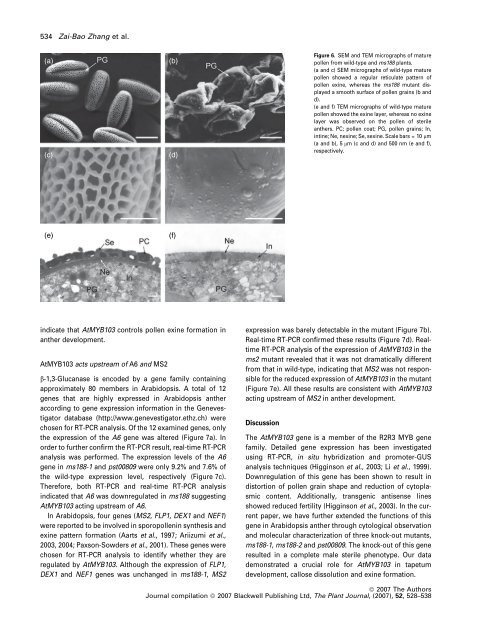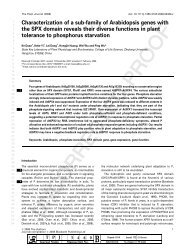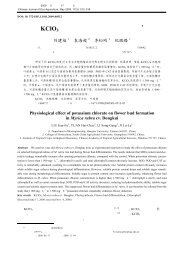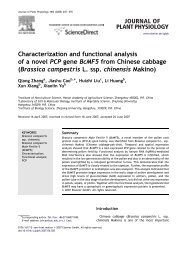You also want an ePaper? Increase the reach of your titles
YUMPU automatically turns print PDFs into web optimized ePapers that Google loves.
534 Zai-Bao Zhang et al.<br />
(a)<br />
(c)<br />
(b)<br />
(d)<br />
Figure 6. SEM and TEM micrographs of mature<br />
pollen from wild-type and ms188 plants.<br />
(a and c) SEM micrographs of wild-type mature<br />
pollen showed a regular reticulate pattern of<br />
pollen exine, whereas the ms188 mutant displayed<br />
a smooth surface of pollen grains (b and<br />
d).<br />
(e and f) TEM micrographs of wild-type mature<br />
pollen showed the exine layer, whereas no exine<br />
layer was observed on the pollen of sterile<br />
anthers. PC; pollen coat; PG, pollen grains; In,<br />
intine; Ne, nexine; Se, sexine. Scale bars = 10 lm<br />
(a and b), 5 lm (c and d) and 500 nm (e and f),<br />
respectively.<br />
(e)<br />
(f)<br />
indicate that AtMYB103 controls pollen exine formation in<br />
anther development.<br />
AtMYB103 acts upstream of A6 and MS2<br />
b-1,3-Glucanase is encoded by a gene family containing<br />
approximately 80 members in Arabidopsis. A total of 12<br />
genes that are highly expressed in Arabidopsis anther<br />
according to gene expression information in the Genevestigator<br />
database (http://www.genevestigator.ethz.ch) were<br />
chosen for RT-PCR analysis. Of the 12 examined genes, only<br />
the expression of the A6 gene was altered (Figure 7a). In<br />
order to further confirm the RT-PCR result, real-time RT-PCR<br />
analysis was performed. The expression levels of the A6<br />
gene in ms188-1 and pst00809 were only 9.2% and 7.6% of<br />
the wild-type expression level, respectively (Figure 7c).<br />
Therefore, both RT-PCR and real-time RT-PCR analysis<br />
indicated that A6 was downregulated in ms188 suggesting<br />
AtMYB103 acting upstream of A6.<br />
In Arabidopsis, four genes (MS2, FLP1, DEX1 and NEF1)<br />
were reported to be involved in sporopollenin synthesis and<br />
exine pattern formation (Aarts et al., 1997; Ariizumi et al.,<br />
2003, 2004; Paxson-Sowders et al., 2001). These genes were<br />
chosen for RT-PCR analysis to identify whether they are<br />
regulated by AtMYB103. Although the expression of FLP1,<br />
DEX1 and NEF1 genes was unchanged in ms188-1, MS2<br />
expression was barely detectable in the mutant (Figure 7b).<br />
Real-time RT-PCR confirmed these results (Figure 7d). Realtime<br />
RT-PCR analysis of the expression of AtMYB103 in the<br />
ms2 mutant revealed that it was not dramatically different<br />
from that in wild-type, indicating that MS2 was not responsible<br />
for the reduced expression of AtMYB103 in the mutant<br />
(Figure 7e). All these results are consistent with AtMYB103<br />
acting upstream of MS2 in anther development.<br />
Discussion<br />
The AtMYB103 gene is a member of the R2R3 MYB gene<br />
family. Detailed gene expression has been investigated<br />
using RT-PCR, in situ hybridization and promoter-GUS<br />
analysis techniques (Higginson et al., 2003; Li et al., 1999).<br />
Downregulation of this gene has been shown to result in<br />
distortion of pollen grain shape and reduction of cytoplasmic<br />
content. Additionally, transgenic antisense lines<br />
showed reduced fertility (Higginson et al., 2003). In the current<br />
paper, we have further extended the functions of this<br />
gene in Arabidopsis anther through cytological observation<br />
and molecular characterization of three knock-out mutants,<br />
ms188-1, ms188-2 and pst00809. The knock-out of this gene<br />
resulted in a complete male sterile phenotype. Our data<br />
demonstrated a crucial role for AtMYB103 in tapetum<br />
development, callose dissolution and exine formation.<br />
ª 2007 The Authors<br />
Journal compilation ª 2007 Blackwell Publishing Ltd, The Plant Journal, (2007), 52, 528–538








